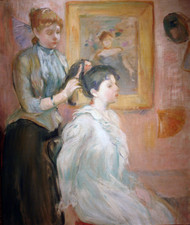Berthe Morisot (1841-1895)
Published by Therese Myles on 17th Sep 2019
This famous French Impressionist portrayed a very wide range of subjects- notably landscapes, still life paintings, and other domestic scenes, as well as a very large amount of portraits. Berthe Morisot is one of the leading women French Impressionists who was able to care out a very unique spot in art among a very male-dominated early art history. Even then, those women who do manage to rise through the ranks of famous artists are still constantly being compared next to other classical Impressionists- an example of how women artists were unfortunately limited in their artistic endeavors.
In this time period, nudes and depictions, especially of males, were expressly forbidden, and women were expected to be mothers before anything else, and painting or other artistic acts were simply ways to pass the time in between motherly duties. Morisot was blessed in the time, however- as her parents and husband were very supportive of her efforts and her arts. Morisot began painting early in life, and she studied in Ecole de Beaux-Arts, and was the youngest daughter out of four children, and was given art lessons as a gift to her as a child from their mother in 1855, and the paintings lessons continued on well after the gift expired, concreting her career in art.
Berthe Morisot's first paintings were accepted by the Salon de Paris in 1864, and she soon became friends with Menet, and they began to paint self-portraits of each other, and she taught Menet about her own plein air technique that encouraged Menet to use brighter, more efficacious colors, and we can also see how their relationship affected her transition from simple landscape painting into figural paintings, which she first exhibited in the salon in 1870.
No matter who influenced who, they both were becoming key Impressionists around the same time as each other, and they were both friends with various other Impressionists like Degas, Gauguin, Alfred Sisley, and Renoir- but unfortunately for Morisot, she was restricted by the times, and her gender and high social status held her back. After the birth of her daughter, she defied the conventions of the social norms by continuing her career, and was constantly criticized and compared to men, and often was forced to paint landscapes and paintings of women and children, because men refused to be painted by her. Fortunately enough for her, painting women has always been popular.
Morisot did most of her work in Paris, and she lived long enough to really see her work become publicly recognized when her painting La femme au bal, sold for 4,500 francs. Eugene Manet left his daughter with her in 1892, and with her health failing, Morisot named her the heir to her will, and she died in 1895 from Pneumonia. Berthe Morisot is one of the first women painters in the history of art to make such a sizable blow for feminism and the arts, and if her particular portraits were destroyed, an important part of history would cease to exist.

